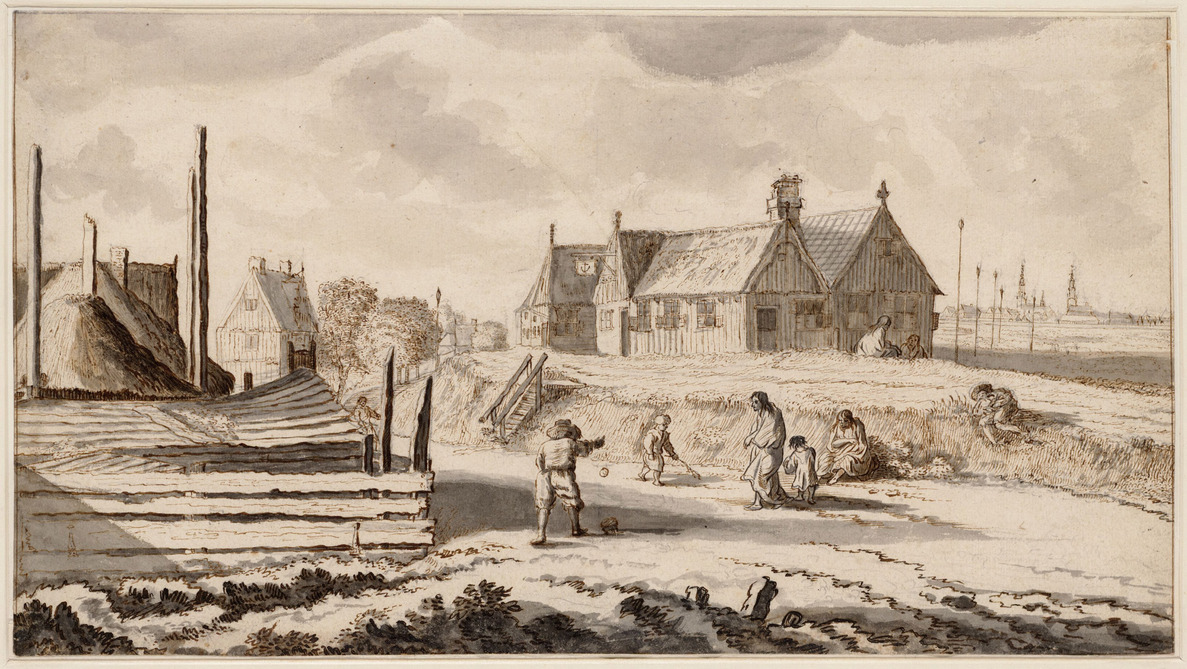The silver interment box from hidden church De Pool
Gerardus van Wijckersloot closes the door of warehouse 'De Pool' behind him. He has tried to leave the building as inconspicuously as possible, though he knows that most people are aware of the hidden Catholic church located in this building. He walks along the IJgracht towards the house where he is supposed to go, encountering a horse and cart along the way. When he reaches the house, he knocks on the front door. A curtain is immediately pushed aside, and shortly after, the door is opened. The maid immediately takes him to the living room where the lady of the house is laid out. Here, Gerardus van Wijckersloot takes a bottle of holy water, and a small silver box from under his cloak. He sprinkles the water over her body. Then, he opens the mysterious box and takes out a small scoop. He slides a silver lid off and scoops out something three times from the box, throwing it into the coffin. Meanwhile, he murmurs prayers. When he is finished, he leaves the house just as inconspicuously as he arrived and begins the walk back to the warehouse.
This mysterious box is small, about 11 cm long and 4.5 cm wide. It is also a very special box, as only four of these silver boxes are known to exist. Inside the box is earth, with a lid on top to which the scoop can be attached. The outside is decorated with images and a so-called memento mori inscription: ‘Gedenckt u uutterse des doots inder eeuwicheydt suldy niet sondygen’ (Dutch: Remember your death and you shall never sin). A memento mori inscription is a text that reminds the reader of their mortality and the need to lead a good life in order to reach heaven after death. In addition to this text, there are also two images on the lid: a skull and an hourglass with wings. These images symbolize death and the transience of life. Today, this box is displayed in a showcase at the Museum Ons’ Lieve Heer op Solder. How this box ended up there will be explained later.
Gerardus van Wijckersloot was the first priest of the hidden church De Pool between 1720 and 1727. He uses this box to bury Catholics in consecrated ground at a time when this was no longer possible. Until the Reformation in the 16th century, everyone was Catholic, and all people were buried in consecrated ground in churchyards and churches. In 1578, this changed with dramatic consequences for Catholics. In this year, the Catholic city government was deposed, and a Reformed city government took its place. This change is known as the Alteration. The result was that from that point on, the Reformed church became the only church allowed to publicly manifest in Amsterdam. This meant that Catholic churches were then used for Reformed church services. All cemeteries became public cemeteries.
Therefore, since 1578, it has been impossible for Catholics to bury their dead in consecrated ground. This was a great loss for them. For this reason, the priest took this box to the house of the deceased and performed the ritual, just as Gerardus van Wijckersloot did. This ritual involves saying prayers while the priest incenses the body of the deceased, sprinkles it with holy water, and then scoops three small scoops of consecrated earth from the box and throws them into the coffin. Afterward, the coffin is closed and taken to the place where the deceased will be buried. In the case of wealthy citizens, this is often in a former Catholic church, preferably as close as possible to where the main altar once stood. Less wealthy people are buried in a public cemetery.
The silver burial box, as it is now displayed in the showcase at the Museum Ons’ Lieve Heer op Solder, has had a long journey.
In 1651, it was made by the Haarlem silversmith Pieter Cornelisz Ebbekin, commissioned by a priest from Amsterdam. Ebbekin was part of a wealthy Haarlem family of artists. Although he was Reformed, he nevertheless worked on commissions for Catholic churches. This shows that the divide between followers of different religions was not so strict.
The journey of the box continues to Amsterdam. Here, it ends up in a small church in Oetewaal, dedicated to Saint Anna. Oetewaal was a small village near Amsterdam, now located near the old Oranje Nassau Barracks. In 1663, the church was demolished during an expansion of the city of Amsterdam, and Oetewaal became part of Amsterdam. Subsequently, a number of successive locations hosted a church dedicated to Saint Anna. First in Brouwerij de Perel on Oostenburg, then in Huis de Ploeg on the Grote Kattenburgerstraat, and later at the Kattenburgerplein. In 1720, the church was established in the warehouse on the IJgracht (now the Prins Hendrikkade) called De Pool, named after the former owner Ambrosius Pool. The box would remain here between 1720 and 1888.
hidden church
Building in which hidden religious services were held in the Dutch Republic (1588-1795). Christian denominations outside the Calvinist church, such as Catholics, Lutherans, Mennonites and Remonstrants, had to practice their religions in hidden churches.
Holy water
Water blessed by a priest for use in blessings.
Consecrated ground
Ground that has been blessed and is therefore suitable for Christian burial.

View of the village Oetewaal (Also known as Houtewael), c. 1660. City Archives Amsterdam.
De Pool is a so-called clandestine church. This term refers to houses that served as churches without the outward appearance of a church. From the moment Catholics no longer had their own churches—since these were now in the hands of the public Dutch Reformed Church—they had to hold their services elsewhere. This had to be inconspicuous, so they initially gathered in the homes of wealthy Catholic families. Slowly, more such places began to appear throughout the city. Beautiful Catholic hidden churches arose behind the facades. The city government knew that a church was hidden in the canal house De Pool and tolerated it, as long as there were no public expressions of Catholicism. This is why Gerardus van Wijckersloot carried the box so secretly through the streets.
What happened to the box afterward? At the beginning of the 19th century, a new era began for the box. Catholics were again allowed to publicly practice their faith, and soon the first consecrated cemeteries were established. The box lost its original function. It most likely took on a new role as a small storage box for the ashes used by the priest to make the sign of the cross on the foreheads of the faithful on Ash Wednesday. With this new function, the box remained in De Pool until 1888. In 1888, it was eventually taken out of use and ended up at Museum Amstelkring, now Museum Ons’ Lieve Heer op Solder. Here, various objects have been collected to tell the story of Catholics in the city of Amsterdam.
Anouk Verhoeven
Student minor Religieus erfgoed in Amsterdam (Vrije Universiteit/Reinwardt Academie)
Last edited
June 19, 2025
The interment box in the permanent exhibition of Our Lord in the Attic Museum, P.C. Ebbekin, 1651, silver. Collection Our Lord in the Attic Museum.
View on the village Oetewaal (Also known as Houtewael), Jan Gabriëlsz. Sonjé, c. 1660, drawing. Collection Atlas Splitgerber, City Archives Amsterdam.
Biesboer, Pieter, Een rooms-katholieke kunstenaarsfamilie in Haarlem en hun kerkelijke opdrachten, in: Jaarboek Haarlem 2007 (Meppel 2007) 60–79.
Citroen, Karel A., Haarlemse zilversmeden en hun merken (Haarlem 1988).
Frijhoff, Willem, Dynamisch erfgoed (Amsterdam 2007).
Mudde, Cornelis J., Rouwen in de marge. De materiële rouwcultuur van de katholieke geloofsgemeenschap in vroegmodern Nederland (Utrecht 2018).
Roever, Margreet de en Jan Bierenbroodspot, De begraafplaatsen van Amsterdam (Amsterdam 2004).
“Begraven in kerken”, Ons Amsterdam, https://onsamsterdam.nl/begraven-in-kerken, 15 december 2020.




